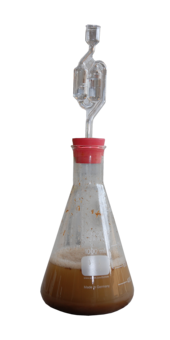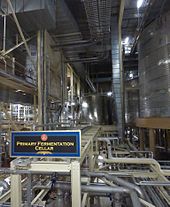Ethanol fermentation

Ethanol fermentation, also called alcoholic fermentation, is a biological process which converts sugars such as glucose, fructose, and sucrose into cellular energy, producing ethanol and carbon dioxide as by-products. Because yeasts perform this conversion in the absence of oxygen, alcoholic fermentation is considered an anaerobic process. It also takes place in some species of fish (including goldfish and carp) where (along with lactic acid fermentation) it provides energy when oxygen is scarce.[1]
Ethanol fermentation is the basis for alcoholic beverages, ethanol fuel and bread dough rising.
Biochemical process of fermentation of sucrose


The chemical equations below summarize the fermentation of sucrose (C12H22O11) into ethanol (C2H5OH). Alcoholic fermentation converts one mole of glucose into two moles of ethanol and two moles of carbon dioxide, producing two moles of ATP in the process.
- C6H12O6 + 2 ADP + 2 Pi → 2 C2H5OH + 2 CO2 + 2 ATP
Sucrose is a sugar composed of a glucose linked to a fructose. In the first step of alcoholic fermentation, the enzyme invertase cleaves the glycosidic linkage between the glucose and fructose molecules.
Next, each glucose molecule is broken down into two
- C6H12O6 + 2 ADP + 2 Pi + 2 NAD+ → 2 CH3COCOO− + 2 ATP + 2 NADH + 2 H2O + 2 H+
CH3COCOO− is pyruvate, and Pi is inorganic phosphate. Finally, pyruvate is converted to ethanol and CO2 in two steps, regenerating oxidized NAD+ needed for glycolysis:
- 1. CH3COCOO− + H+ → CH3CHO + CO2
catalyzed by pyruvate decarboxylase
- 2. CH3CHO + NADH + H+ → C2H5OH + NAD+
This reaction is catalyzed by alcohol dehydrogenase (ADH1 in baker's yeast).[3]
As shown by the reaction equation, glycolysis causes the reduction of two molecules of NAD+ to NADH. Two ADP molecules are also converted to two ATP and two water molecules via substrate-level phosphorylation.
Related processes
Fermentation of sugar to ethanol and CO2 can also be done by Zymomonas mobilis, however the path is slightly different since formation of pyruvate does not happen by glycolysis but instead by the Entner–Doudoroff pathway. Other microorganisms can produce ethanol from sugars by fermentation but often only as a side product. Examples are[4]
- Heterolactic acid fermentation in which Leuconostoc bacteria produce lactate + ethanol + CO2
- Mixed acid fermentation where Escherichia produce ethanol mixed with lactate, acetate, succinate, formate, CO2, and H2
- 2,3-butanediol fermentation by Enterobacterproducing ethanol, butanediol, lactate, formate, CO2, and H2
Gallery
-
Grapes fermenting during wine production.
-
Glucose depicted in Haworth projection
-
Pyruvate
Effect of oxygen
Fermentation does not require oxygen. If oxygen is present, some species of yeast (e.g., Kluyveromyces lactis or Kluyveromyces lipolytica) will oxidize pyruvate completely to carbon dioxide and water in a process called cellular respiration, hence these species of yeast will produce ethanol only in an anaerobic environment (not cellular respiration). This phenomenon is known as the Pasteur effect.
However, many yeasts such as the commonly used baker's yeast
Bread baking

Ethanol fermentation causes bread dough to rise. Yeast organisms consume sugars in the dough and produce ethanol and carbon dioxide as waste products. The carbon dioxide forms bubbles in the dough, expanding it to a foam. Less than 2% ethanol remains after baking.[5][6]
In a contemporary advancement, a group in Germany has been doing the opposite and converting stale bread into ethanol.[7]
Alcoholic beverages

Ethanol contained in alcoholic beverages is produced by means of fermentation induced by yeast.
- fermented beverages.
- Mead is produced by fermentation of the natural sugars present in honey.
- amylase-induce fermented with saliva in a few countries. Whiskey and vodka are also distilled; ginand related beverages are produced by the addition of flavoring agents to a vodka-like feedstock during distillation.
- Rice wines (including sake) are produced by the fermentation of grain starches converted to sugar by the mold Aspergillus oryzae. Baijiu, soju, and shōchū are distilled from the product of such fermentation.
- Rum and some other beverages are produced by fermentation and distillation of sugarcane. Rum is usually produced from the sugarcane product molasses.
In all cases, fermentation must take place in a vessel that allows carbon dioxide to escape but prevents outside air from coming in. This is to reduce risk of contamination of the brew by unwanted bacteria or mold and because a buildup of carbon dioxide creates a risk the vessel will rupture or fail, possibly causing injury or property damage.[citation needed]
Feedstocks for fuel production
Yeast fermentation of various carbohydrate products is also used to produce the ethanol that is added to gasoline.
The dominant ethanol feedstock in warmer regions is sugarcane.[8] In temperate regions, corn or sugar beets are used.[8][9]
In the United States, the main feedstock for the production of ethanol is currently corn.
In some parts of Europe, particularly France and Italy,
Cassava as ethanol feedstock
Ethanol can be made from mineral oil or from sugars or starches. Starches are cheapest. The starchy crop with highest energy content per acre is cassava, which grows in tropical countries.
Thailand already had a large cassava industry in the 1990s, for use as cattle feed and as a cheap admixture to wheat flour. Nigeria and Ghana are already establishing cassava-to-ethanol plants. Production of ethanol from cassava is currently economically feasible when crude oil prices are above US$120 per barrel.
New varieties of cassava are being developed, so the future situation remains uncertain.
Currently, cassava can yield between 25 and 40 tonnes per hectare (with irrigation and fertilizer),
The yeast used for processing cassava is Endomycopsis fibuligera, sometimes used together with bacterium Zymomonas mobilis.
Byproducts of fermentation
Ethanol fermentation produces unharvested byproducts such as heat, carbon dioxide, food for livestock, water, methanol, fuels, fertilizer and alcohols.[17] The cereal unfermented solid residues from the fermentation process, which can be used as livestock feed or in the production of biogas, are referred to as Distillers grains and sold as WDG, Wet Distiller's grains, and DDGS, Dried Distiller's Grains with Solubles, respectively.
Microbes used in ethanol fermentation
- Yeast
- Zymomonas mobilis (a bacterium)
See also
- Anaerobic respiration
- Cellular respiration
- Cellulose
- Fermentation (wine)
- Yeast in winemaking
- Auto-brewery syndrome
- congener)
References
- ISBN 978-0849342264.
- ISBN 978-0716701743.[page needed]
- PMID 25157460.
- ISBN 978-0470015902. Archived from the original(PDF) on 2014-09-08. Retrieved 2014-09-08.
- PMID 9602932.
- PMID 20316063.
- ^ "Wie aus altem Brot Alkohol wird". Deutschlandfunk Nova. 2 March 2024. Retrieved 7 March 2024.
- ^ a b c James Jacobs, Ag Economist. "Ethanol from Sugar". United States Department of Agriculture. Archived from the original on 2007-09-10. Retrieved 2007-09-04.
- ^ "Economic Feasibility of Ethanol Production from Sugar in the United States" (PDF). United States Department of Agriculture. July 2006. Archived from the original (PDF) on 2007-08-15. Retrieved 2007-09-04.
- ^ "Ethanol Biorefinery Locations". Renewable Fuels Association. Archived from the original on 30 April 2007. Retrieved 21 May 2007.
- ^ "Tiny super-plant can clean up hog farms and be used for ethanol production". projects.ncsu.edu. Archived from the original on July 18, 2020. Retrieved 2018-01-18.
- ^ Caroline Wyatt (2006-08-10). "Draining France's 'wine lake'". BBC News. Retrieved 2007-05-21.
- ^ Capone, John (21 November 2017). "That unsold bottle of Merlot is probably winding up in your gas tank". Quartz. Retrieved 21 November 2017.
- ^ Japan Plans Its Own Green Fuel by Steve Inskeep. NPR Morning Edition, May 15, 2007
- ^ "Agro2: Ethanol From Cassava". Archived from the original on 2016-05-19. Retrieved 2010-08-25.
- ^ Pimentel, D. (Ed.) (1980). CRC Handbook of energy utilization in agriculture. (Boca Raton: CRC Press)
- ISBN 978-0-7414-0646-0.[page needed]
- .
- .
- PMID 4954284. (Article in French)

![{\displaystyle {\ce {C12H22O11{}+H2O->[{\text{Invertase}}]2C6H12O6}}}](https://wikimedia.org/api/rest_v1/media/math/render/svg/d5b821ec8da4bd9dd7f6dec5ee66a5d04390a13c)




